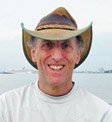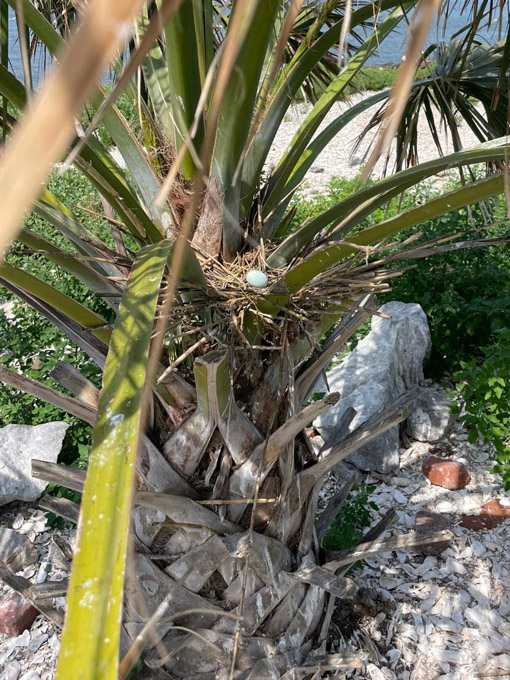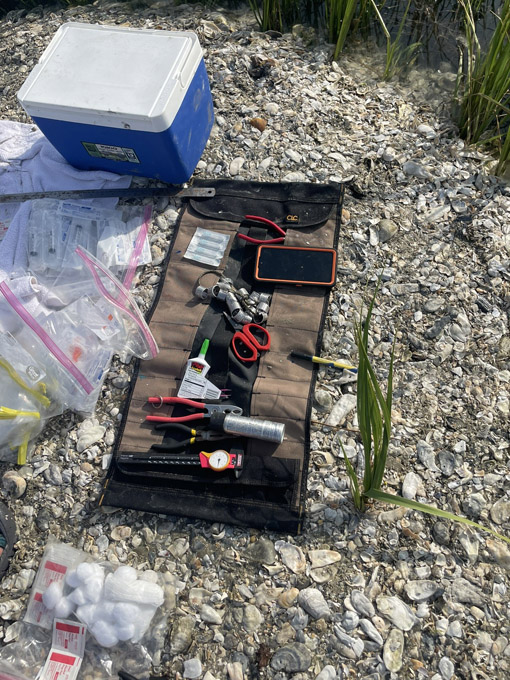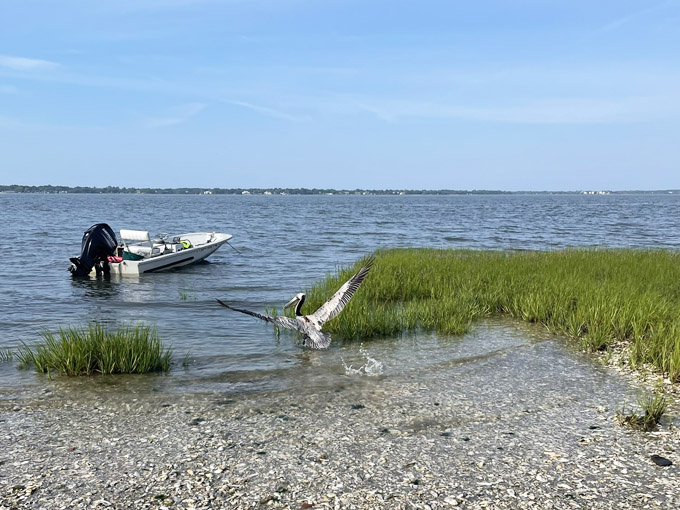The four-month-long project launched in April to study coastal birds residing in and near Charleston Harbor ─ including Castle Pinckney ─ is “progressing on schedule” toward its midway point, according to Dr. Patrick Jodice, who is leading the project’s team of six scientists.
This is the first update since the project began. (See initial story, posted on April 21, 2024)

Dr. Patrick Jodice
“I expect us to be able to complete all of our objectives for April and May (the project’s first two phases) on schedule,” Dr. Jodice said. “The weather has not affected our schedule, and we’ve been able to operate safely and without incident.”
The study’s objectives are to:
- Evaluate the bioaccumulation of a wide range of per-and polyfluoroalkyl substances (IPFAS) in local food webs that support coastal birds at sites in and around Charleston Harbor,
- Measure the contaminants in Eastern Brown Pelicans and American Oystercatchers, and
- Collect eggs (no more than one per nest), feathers and other samples from the birds to measure the contaminants.
The scientists are attaching tracking devices to adult coastal birds to identify the areas they use. The tags are providing GPS locations (movement data) via satellites from birds as they move to sites across the harbor as well as sites along the Ashley, Cooper and Wando rivers. This is enabling the scientists to assess contaminant exposure throughout the birds’ food webs.
The Study’s First Two Phases
Work days vary.
Dr. Jodice and his fellow scientists have been departing Shem Creek by boat about 7 a.m. most days, and arriving at sites in Charleston Harbor, including Castle Pinckney, to conduct their work since the project began two months ago.
The scientists have been trapping and handling birds during the cooler hours each morning, trying hard not to disrupt the bird colonies where nests are located, eggs are incubating, and adult birds are rearing chicks.
Before landing at a site each morning to conduct their work, they always take time to assess the condition of birds from a distance to determine if they are behaving normally, or if something is agitating them and making them “flighty.” The scientists only proceed with their work at a site if the situation looks normal.

Heron nest in a Palmetto Tree at Castle Pinckney.
Notice the egg in the center of the nest.
“Honestly, one of the most important aspects of our work is constantly assessing how birds are reacting to us as we work at sites,” explained Dr. Jodice, who has been studying bird colonies for about 25 years. “It’s a skill our team has cultivated over long periods of time, and we spend a lot of time training new team members on this issue.
“While you’re on a bird colony, you’re always ─ always ─ vigilant about how birds are behaving,” he added. “The research we’re doing is important, but we value the well-being of these colonies very highly. For example, we often decide to ‘give a colony a rest’ if we put in a long day or two at a site.”

Tagging and setup at a site in Charleston Harbor
Their scientific team’s careful work is paying off.
“We’ve successfully collected our target sample of eggs, deployed all but a couple of tags, and started collecting environmental samples,” Dr. Jodice said. “Lately, we’ve primarily been capturing and tagging birds. So, we’ve been scouting for nests that we can focus on as ‘capture nests’ and patiently trying to catch adult birds.”
Capturing and tagging an adult bird is not for the fainthearted. Typically, the scientists are able to capture and tag at least a few adult birds each day.
“Capture and handling work, while exciting, is very tedious and focused,” Dr. Jodice explained. “Handling live, wild animals, requires substantial skill, patience and intuition. Each adult bird generates a fair amount of work for the team in terms of samples collected, and samples need to be organized and managed.
“If we’re unsuccessful capturing an adult bird after one or two attempts, or if an adult bird seems very wary,” he added, “we move on to another nest or another area of a colony to keep disturbance to a minimum.”

A Pelican takes flight after it is tagged and released.
The scientists have been conducting their work at sites early every day partly because there is less boat traffic in the harbor, and partly to avoid the heat. But their workdays do not end when they return to Shem Creek because there is a substantial amount of work for them to do after they have captured, tagged and released adult birds.
“We easily spend two or three hours sample processing, storing samples, and entering data after we return to Shem Creek,” Dr. Jodice noted.
Weekly schedules are dictated by the weather. So, the scientists try to visit sites and collect samples whenever weather permits to avoid falling behind schedule if they are unable to work one or more days due to inclement weather.
Phases Three and Four
The scientific team will soon begin the study’s last two phases.
Dr. Jodice believes his team will be able to complete the most challenging aspects of the project ─ collecting pelican eggs and tagging adult pelicans ─ during the study’s third phase, which begins in June. He plans to be able to collect any remaining environmental samples during the project’s fourth and final phase, which begins in July.
From a logistics standpoint, the project’s last two phases are expected to be easier than the first two.
“There is a lot to keep track of and to prepare for when conducting this many captures, and while it’s rewarding and exciting, it can also be tiring over a period of several weeks,” Dr. Jodice explained. “So, as we focus on the last few captures, it’s nice to know that the upcoming field work will be a bit less stressful and a bit easier to plan.”
Scientists Expect to Know More by Mid to Late July
At this point, it is too early for the scientists to report any findings.
“We can say that we’ve been able to successfully and safely capture adults from species, deploy tags efficiently, and begin to see the data arrive from those tags,” Dr. Jodice said. “But most of the birds have only been tagged and transmitting for a couple of weeks.
“So, we need to remain patient until we have a better sense of the patterns that are emerging from the movement data,” he added. “We should know much more about the movement of the birds that we’ve tagged by mid to late July after we’ve collected more movement data over a longer period.”
Protected bird sanctuaries in Charleston Harbor, like Castle Pinckney and Crab Bank, are important for coastal birds.
“We are fortunate to have these islands,” Dr. Jodice said. “But we also appreciate the stakeholders, who monitor and care for these islands, who make it possible for scientists like us to have a place to do our research. We do not take this access for granted, and want to do what we can to contribute to the long-term persistence of these sites.
“Being able to share our experiences with groups like the Castle Pinckney Historical Preservation Society, and anyone who visits this site,” he added, “is a great way to be able to do this.”
A second and final update on the scientific team’s study will be posted on this site in July.
